
FAIR is a non-profit organization dedicated to providing well-documented answers to criticisms of the doctrine, practice, and history of The Church of Jesus Christ of Latter-day Saints.
Summary: It is claimed that facsimile 1 is simply a typical funerary scene and there are many other papyri showing the same basic scene, and that the missing portions of the drawing were incorrectly restored. It is also claimed that Abraham has never been associated with the lion couch vignette such as that portrayed in Facsimile #1 of the Book of Abraham.
Jump to details:
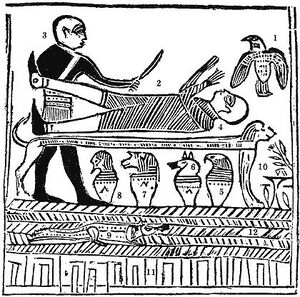
The following claims are made regarding Facsimile 1:
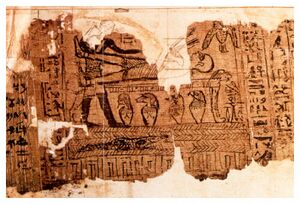
The papyrus with the illustration represented in Facsimile 1 (view) is the only recovered item that has any connection to the text of the Book of Abraham.
This vignette is called a "lion couch scene" by Egyptologists. It usually represents the embalming of the deceased individual in preparation for burial. However, this particular lion couch scene represents the resurrection of Hor (figure 2), aided by the Egyptian god Anubis (3).[1]
Abraham 1꞉12 and the notes to Facsimile 1 identify it as representing Abraham being sacrificed by the priest of Elkenah in Ur.
The Larson restoration presumes that the upper hand represented in Facsimile 1 is instead the wing of a bird. There are several elements which disprove this.
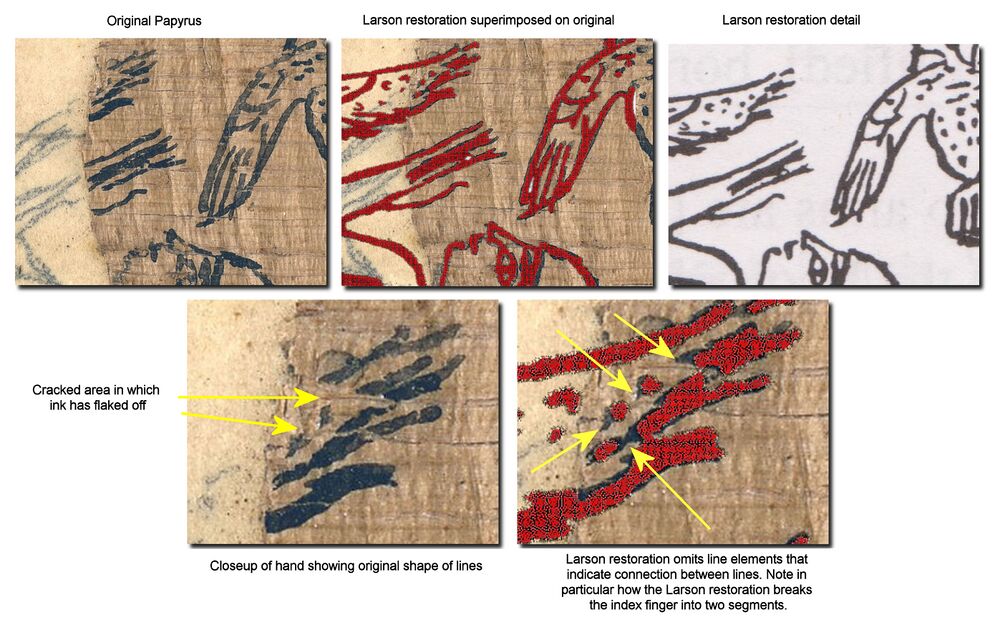
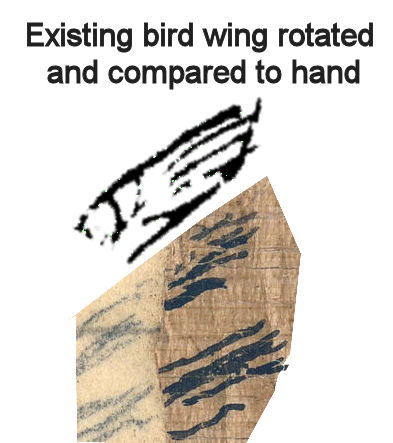
Although many similar lion couch scenes exist, this one has quite a few unique features:
Therefore, we do not agree that it is the "same funeral scene." Facsimile 1 actually depicts the resurrection of Osiris. The figure on the couch is alive. The figures to which it is compared all show the preparation of a mummy.
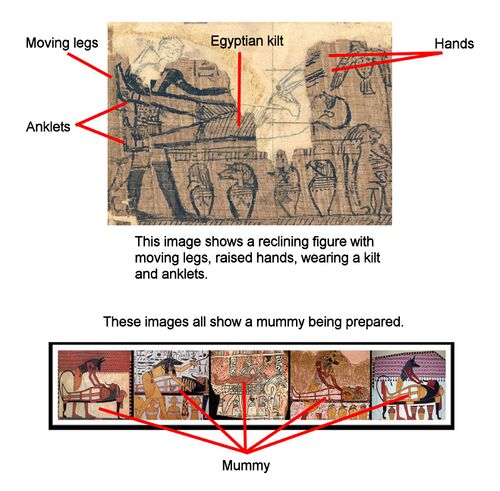

Angels or heavenly messengers were frequently represented by birds in Egyptian literature. This is an element more contemporary to a later redactor and/or copyist of the Book of Abraham. The Egyptian word for angel is " 'ḫ". The Greek word for angel is "ἄγγελος". In the respective lore, they could potentially turn into birds and bring messages from God. Additionally, see above for traditions that mention the appearance of an angel to Abraham.
The Egyptian term for angel is 'ḫ. The term “designates entities or beings . . . [and] their
(spirit-)state and the power emanating from them.” It was part of a larger spiritual world. The Egyptian spirit world was generally divided into three classes: gods [Egyptian and Greek translation included], angels [Egyptian and Greek translation included], and demons [Egyptian and Greek translation included]. The larger category of these beings was the spirit [Egyptian and Greek translation included]. When an individual died, his or her soul [Egyptian and Greek translation included] either became an angel [Egyptian and Greek Translation included] or a demon [Egyptian and Greek translation included] depending on whether the proper rites had been performed, and whether he or she had lived properly.
[. . .]
These are all features of the 'ḫ, who had power over the damned, and the living, could cause health, sickness, childbirth, financial distress, or general malady. They could also send dreams, lead men and women, do work, fight demons, light lamps, kill, move ships, transform themselves into lotuses, barley, falcons, phoenixes, herons, geese, swallows, ibises, vultures, other birds, bulls, crocodiles, snakes, spirits, gods, fire, air, whatever form desired, and in that form they could appear in various places, to whomever they wished. They open doors, travel through fire, loose bonds, drive away crocodiles, snakes, vultures, pigs, cockroaches, and other undesirable creatures, control water, winds, fire, and enemies, brings bread, water, beer, and other foods.
As shown in the following table, the descriptions overlap considerably showing that the Roman period
description is a continuation of previous pharaonic understandings, and that both ἄγγελος and [other Greek terms are attempts to render the Egyptian term 'ḫ into Greek.[2]

Human sacrifice is well attested in ancient Egypt. It was common to those who rejected the standing religious order as a human sacrifice to the Gods as form of capital punishment. This was virtually unknown during Joseph Smith's day. He could only have learned this information from revelation.
Pearl of Great Price Central:
While scholars might disagree on what precise terminology to use, there is, in the words of one Egyptologist, “indisputable evidence for the practice of human sacrifice in classical ancient Egypt.” Some of the evidence for this practice dates to the likely time of Abraham (circa 2,000–1,800 BC). “The story presented in the Book of Abraham matches remarkably well with the picture of ritual slaying” in Egypt during the same time period, concludes two Egyptologists in a study of this evidence.
The existence of human sacrifice in ancient Egypt has been variously debated and denied. While Egyptologists generally admit that the practice existed in the formative periods of Egyptian society, opinions among Egyptologists for later time periods range from claiming that "there is no certain evidence for the practice of human sacrifice . . . from the Old Kingdom onwards" to asserting that there is "indisputable evidence for the practice of human sacrifice in classical ancient Egypt." However difficult it may be for modern societies to accept that a practice we detest, such as human sacrifice, occurred in past civilizations we admire, further research and discoveries necessitate a reassessment of the possibility of this practice within Egyptian culture. While there is not a universally accepted definition of human sacrifice, for the purposes of this paper we will define human sacrifice as the slaying of a person in a ritual context.
Of interest in this publication is the citation of Dr. Robert Ritner (the most vocal critic of the Book of Abraham) in support of human sacrifice in ancient Egypt. His quote: "[there is] indisputable evidence for the practice of human sacrifice in classical ancient Egypt."[3]

Traditions about Abraham confirm that he was nearly sacrificed and that he was bound upon an altar. See above for the extrabiblical traditions that testify to this. Additionally, scholars have found links between Abraham and Osiris in Semitic adaptations of Egyptian lore. There has also been another papyrus located that associates Abraham with a lion couch scene.
Kevin Barney:
The adaptation of an Egyptian psychostasy vignette from chapter 125 of the Book of the Dead in the judgment scene of the Testament of Abraham, the adaptation of the Egyptian original underlying the Demotic Story of Setna in a Jewish popular version (replacing Osiris with Abraham), and the adaptation of a hypocephalus in the Apocalypse of Abraham provide a stunning glimpse of how J-red, living and working in the same era, may have adapted vignettes from a Book of Breathings and a hypocephalus as illustrations of the Book of Abraham, which had come under his care as a part of the ancient transmission of the text. In my view, the Semitic Adaptation theory turns the facsimiles and their interpretations from a perceived weakness of the Book of Abraham into a real strength.[4]
Another lion couch scene has been discovered which actually includes Abraham's name. It should be noted that the article that this papyri was included in does not claim that Abraham is the figure on the lion couch, and notes that "[t]he figure on the lion couch in this papyrus is a woman." That is very clear from looking at the papyrus. However, the wording under the figure states "Abraham upon..." ("Abraham epi" in Greek) and then it becomes unintelligible so scholars are at a stand-still as to knowing if the circling of the name of Abraham in that phrase is the identification of the figure as Abraham. It is very arguable, however, that with the preposition ("epi" meaning things ranging from "at", to "near" to "upon") and the circling of Abraham's name that this is an identification of Abraham as the figure on the couch in some form. This can simply not be demonstrated conclusively.[5]
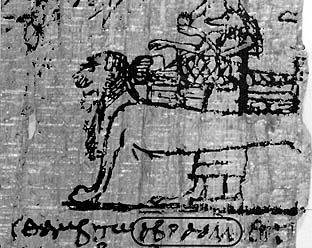

Pearl of Great Price Central:
What do we know about the ancient god Elkenah? No deity of that name is mentioned in the KJV Bible, but in the last century archaeologists have unearthed evidence of his worship.
Elkenah is very likely the shortened form of the name of the Canaanite god El koneh aratz, meaning “God who created the earth” (or “God, creator of earth”). Among the ancient Hittites living in Asia Minor he was known as Elkunirsha.

Pearl of Great Price Central:
Even if some “issues concerning the accuracy of both the artwork and the copying [of Facsimile 1]” remain unanswered at the moment (issues which, unfortunately, “are routinely clouded by shifting the responsibility of the artwork from the engraver, Reuben Hedlock, to Joseph Smith, without adducing any evidence to identify a particular individual with the responsibility for the restorations”), the identification of this figure as a priest is not outside the realm of possibility from an Egyptological perspective.
The idolatrous Gods of Elkenah, Libnah, Korash, and Mahmakrah have been identified as Gods worshipped by ancient Mesopotamians. Along with the commentary of scholars below, Hugh Nibley has shown how the names of these deities would be associated with the canopic jars depicted here in his book "An Approach to the Book of Abraham".
Although unknown as deities in Joseph Smith’s day, the names of four associated idolatrous gods (Elkenah, Libnah, Mahmackrah, and Korash) mentioned in the Book of Abraham are attested anciently. Two of them are known to have connections with the practices attributed to them in the Book of Abraham. The odds of Joseph Smith guessing the names correctly is astronomical.
Michael Rhodes:
The names of the idolatrous gods mentioned in facsimile 1 provide another example of the validity of the Prophet Joseph’s explanations. If Joseph Smith had simply made up the names, the chances of their corresponding to the names of ancient deities would be astronomically small. The name Elkenah, for example, is clearly related to the Hebrew ttt ‘el q?n?h/ q?neh “God has created / the creator.” Elkenah is found in the Old Testament as the name of several people, including Samuel’s father (see 1 Samuel 1:1). The name is also found as a divine name in Mesopotamian sources as dIl-gi-na / dIl-kí-na / dÉl-ké-na. Libnah may be related to the Hebrew leb?n?h “moon” (see Isaiah 24:23) from the root l?b?n “white.” A city captured by Joshua was called libn?h (see Joshua 10:29). The name Korash is found as a name in Egyptian sources. A connection with K?reš the name of the Persian king Cyrus (Isaiah 44:28), is also possible.[6]
John Tvedtnes:
John Gee and others have more recently reexamined the names and come to similar conclusions. John M. Lundquist also noted that each of the gods or idols mentioned in Abraham 1:17 appears in the compilation of some 3,800 Mesopotamian deities published in 1950 by Anton Deimel. Many of these names are Akkadian a Semitic language related to Hebrew and more distantly to Egyptian.[7]
Hugh Nibley (framing his thought process in an imaginary dialogue) regarding how the four canopic jars could be both Mesopotamian gods and the four quarters of the earth (as found in Fac 2) argued:
. . . As far as the Egyptians were concerned, the four quarters of the earth were people. If the Book of Abraham wants to think of the four canopic jars as representing idolatrous gods and the four regions at the same time, this is entirely in keeping with the way the Egyptians thought about it. Now right here in the temple of Opet where we are so much at home "the genies of the four winds" enjoy a conspicuous display, and why are they there? The four winds, according to our handbook, head the list of more than fifty ritual appearances of the sacred four---it all began with the four winds and the four directions, represented as early as the Pyramid Texts by the four canopic vases.[8]
[...]It has been found that all these combinations have one thing in common--what Professor Constant de Wit calls the "quaternary principle"; he suggests that the whole business originally goes back to the four winds and probably started at Heliopolis.
Dick: Naturally
Mr. Jones: On good evidence. Even one of the Joseph Smith Papyri shows that.
Jane: Which one?
Mr. Jones: Fragment No. 8 in the Era listing, corresponding to chapter 5 of the Book of the Dead.[9] Allen has rendered it: "His nose is open in Busiris. He rests in Heliopolis. . . . If north winds come, he sits in the south; if south winds come, he sits in the north; if west winds come, he sits in the east; if east winds come, he sits in the west.[10]
[...]Mr. Jones: The animal heads seem to have been borrowed by the Egyptians in the first place. Originally the canopic vases didn't have the animal heads; they were just plain jars.[11] Scholars believe "that the theriomorphic vase in Egypt, as elsewhere can be traced to an origin in North Syria."[12] Yet the four heads are already canonically prescribed in the Pyramid Texts, so that it is suggested that their appearance in Egypt in the Nineteenth Dynasty was actually a return to the old idea.[13] The idea behind the canopic figures was certainly familiar to Canaan, where, according to the rabbis, the princes of the various nations were typified by animals, just as were the princes of Israel.[14]
Dick: But only four of them?
Mr. Jones: That was a concession to the system. Thus, though from time immemorial the Egyptians spoke of the other nations as the "Nine Bows," they believed that at the judgement the four races of mankind would stand in their proper positions.[15] Professor Georges Posener has shown that the Egyptians named the peoples and countries of the world after their directions and hence conceived of the four cardinal directions; to each of the cardinal directions they also gave cardinal colors--red, white, black, and green.[16] They knew that there were many countries, of course, but they insisted on fitting everything into the system--a sort of cosmic plan that seems to have hypnotized many ancient people.[17]
Dick: So, nobody had to borrow from anybody.
Mr. Jones: So, the various ideas could easily meet and fuse--in Canaan, especially, the newly found Brooklyn Papyrus shows the people familiar with the same ideas: "The invoking of the four Babylonian deities is certainly evidence of the presence of a Babylonian cult in this area." The four gods in question happen to be Bel, Nabu, Shamash, and Nergal[18] corresponding closely to the four great gods of the Egyptian four directions.[19]

Pearl of Great Price Central:
A strong case can be made for identifying the “god of Pharaoh” in the Book of Abraham as the Egyptian deity Sobek. This god was worshipped even before Abraham’s day and was commonly depicted as either a crocodile-headed man or a full crocodile wearing a crown. Anciently “he was regarded as a powerful deity with several important associations,” among them “procreative and vegetative fertility” and, importantly for the Book of Abraham, “the Egyptian king . . . as a symbol of pharaonic potency and might.”
Foreigners in Egypt, like Abraham was, are often represented by a Lotus Flower (sometimes referred to alternatively as a water lily), the figure depicted here, as argued by Dr. Hugh Nibley. Nibley cites Waltraud Guglielmi, a non-LDS Egyptologist, to support his assertion specifically referencing divine and human visitors in Egypt.
The lotus, perhaps the richest of all Egyptian symbols, can stand for the purest abstraction, as when it indicates nothing but a date in one tomb or a place in another.[20] In Facsimile 3 we are told that it points to two things, a man and a country, indicating the special guest-to-host relationship between them. Most of the time the lotus announces a party situation, adding brightness to the occasion; etiquette required guests to a formal party to bring a lotus offering to the host--hence the flower served as a token both of invitation and admission.[21] [E.A. Wallis Budge] observed how in the Kerasher Manuscript, in which the person being presented wears exactly the same peculiar lotus headdress as our Shulem (figure 5), "instead of the bullock-skin dripping with blood, which is generally seen suspended near the throne of the god, masses of lotus flowers are represented, giving a totally different aspect to the scene.[22] Yet, while the lotuses "seem to have figured prominently" in formal occasions, according to Aylward Blackman, we still do not understand the flower offerings, any more than we do the combination of lotus stands and small libation vessels such as our figure 3.[23] It would now seem that these tall and narrow Egyptian ritual stands originated in Canaan.[24]
[. . .]The lotus is definitely a welcome to Egypt from the king to human and divine visitors; the divinity who received the token reciprocated by responding to the king "I give thee all the lands of thy majesty, the foreign lands to become they slaves. I give thee the birds, symbols of thine enemies."[25] In receiving a lotus, the king in return ritually receives the land itself, while the god in accepting a lotus from the king promises him in return the reverent obedience of his subjects.[26] "The flowers are mostly heraldic plants . . . associated with the crowns of Upper and Lower Egypt," for in some the main purpose of the lotus rites is to "uphold the dominion of the King" as nourisher of the land.[27] Moreover, its significance is valid at every level of society, the lotus being a preeminent example of how mythological themes and religious symbolism were familiarly integrated into the everyday life of the Egyptians.[28]
[. . .]
The numerous studies of the Egyptian lotus design are remarkably devoid of conflict, since this is one case in which nobody insists on a single definitive interpretation. The points emphasized are (1) The abstract nature of the symbol, containing meanings that are far from obvious at first glance (2) the lotus as denoting high society, especially royal receptions, at which the presentation of a lotus to the host was obligatory [. . .]; to be remiss in lotus courtesy was an unpardonable blunder, for anyone who refuses the lotus is under a curse, (3) the lotus as the symbol of Lower Egypt, the Delta with all its patriotic and sentimental attachments ; (4) the lotus as Nefertem, the defender of the border; (5) the lotus as the king or rule, defender, and nourisher of the land; (6) the lotus as the support of the throne at the coronation. It is a token of welcome and invitation to the royal court and the land, proffered by the king himself as guardian of the border.[29]
Kevin Barney:
In Hebrew cosmology, the raqîa’ or “firmament” was believed to be a solid dome, supported by pillars.57 The raqîa’ in turn was closely associated with the celestial ocean, which it supported.58 In the lower half of Facsimile 1, we have the raqîa’ (1) connected with the waters, as with the celestial ocean, (2) appearing to be supported by pillars, and (3) being solid and therefore capable of serving itself as a support, in this case for the lion couch. The bottom half of Facsimile 1 would have looked to J-red very much like a microcosm of the universe (in much the same way that the divine throne chariot of Ezekiel 1—2, which associates the four four-faced fiery living creatures with the raqîa’ above their heads on which God sits enthroned, is a microcosm of the universe). The Egyptian artist’s perspective is not necessarily a limitation on J-red. The stacking effect of waters apparently both being supported and acting as a support would have suggested to J-red the Hebrew conception of the raqîa’.[30]
The Hebrew term "Raukeeyang" is a transliteration of the word "raqîa’". In Figure 12, Joseph Smith describes "Raukeeyang" as the firmament over our heads and a crocodile swims through it. This makes sense in light of modern scholarship that identifies Egyptian's conception of heaven as a "Heavenly Ocean" with this figure. LDS Scholars have cited Non-LDS Egyptologist Erik Hornung whose work supports this.[31]
"Shamau" is presented as related to samayim, a dual form meaning "heaven(s)" "Shaumahyeem" using the Sephardic Hebrew transliteration Joseph learned from Joshua Seixas as opposed to the Ashkenazic method.
Louis Zucker, a Jewish scholar from the University of Utah wrote:
Another such word is Shaumahyeem [exactly the Seixas pronunciation], heavens, in the sense of Genesis 1; Shaumau is an invented singular, unknown to the Bible.[32]
A number of points need to be made about the Restoration of Facsimile 1 to emphasize and clarify other evidences.
There is evidence to suggest that the original figure here would have been Anubis. Priests that were performing sacrifices could either remain without the head of Anubis or with it. It would not matter to the overall message of the scene portrayed. Theologically, it would not matter to scenes such as this one. Ancient art depicting religious situations such as this frequently had other people impersonating other Gods. The priest of Elkenah likely could have been wearing an Anubian headdress while performing this scene and the interpretation would still be correct. [33]
John Gee has written:
The discussion about figure 3 has centered on whether the head should be that of a jackal or a bald man. Whether the head is a jackal or a bald man in no way affects the interpretation of the figure, however, since in either case the figure would be a priest.
His footnote here reads as follows:
The argument for the identification runs as follows:
(1) Assume for the sake of argument that the head on Facsimile 1 Figure 3 is correct. What are the implications of the figure being a bald man? Shaving was a common feature of initiation into the priesthood from the Old Kingdom through the Roman period. Since “Complete shaving of the head was another mark of the male Isiac votary and priest” the bald figure would then be a priest.
(2) Assume on the other hand that the head on Facsimile 1 Figure 3 is that of a jackal, as was first suggested by Theodule Devéria. We have representations of priests wearing masks, one example of an actual mask, [and] literary accounts from non-Egyptians about Egyptian priests wearing masks. . . . Thus, however the restoration is made, the individual shown in Facsimile 1 Figure 3 is a priest, and the entire question of which head should be on the figure is moot so far as identifying the figure is concerned. (John Gee, “Abracadabra, Isaac, and Jacob,” Review of Books on the Book of Mormon 7/1 [1995]: 80–82)[34]
Non-Latter-day Saint Egyptologist Robert Ritner has argued that:
Masks of Anubis and Bes were used for similar identifications during ritual (Murray 1935-38 and Wild 1963, pp. 78-81). The significance of such masking is distorted beyond reason in Wolinski 1986 and 1987; see above, n. 1037. Priestly impersonators of Anubis regularly appear in funerary ceremonies, and are styled simply 'Inpw, "Anubis" or rmt-'Inpw, "Anubis-men"; see Faulkner 1951, pp. 48-49: 'ink 'Inpw, "I am Anubis" (line 6)[.][35]
Gee gives an example of this of a bald priest donning the head of Anubis at the temple of Dendara. The first image is an actual drawing created during the Ptolemaic period from Dendara of the priest putting on the mask. The second is an example of such a mask that would be placed on them.


One early Latter-day Saint who saw the papyri in 1841 described them as containing the scene of an altar with "'a man bound and laid thereon, and a Priest with a knife in his hand, standing at the foot, with a dove over the person bound on the Altar with several Idol gods standing around it.'"[36] Similarly, Reverend Henry Caswall, who visited Nauvoo in April 1842, had a chance to see some of the Egyptian papyri. Caswall, who was hostile to the Saints, described Facsimile 1 as having a "'man standing by him with a drawn knife.'"[37] See here for more information. The best explanation of the figure depicted as the priest sacrificing Abraham is that he is in the martial position, attempting to combat with the figure on the couch. This emphasizes the interpretation of Abraham being sacrificed.
The placement of a hand at this portion of the lacuna is significant since it emphasizes the fact that the figure lying on the couch is alive. The best evidence suggests that this figure was indeed a hand. See here for more information
Another lion couch scene has been discovered which actually includes Abraham's name. Note that it does not claim that Abraham is the figure on the lion couch, and notes that "[t]he figure on the lion couch in this papyrus is a woman." That is very clear from looking at the papyrus. However, the wording under the figure states "Abraham upon..." and then it becomes unintelligible so scholars are at a stand-still as to knowing if the circling of the name of Abraham in that phrase (written in Greek) is the identification of the figure as Abraham. [38]

Also of interest is some correlation between The Book of Abraham and the Apocalypse of Abraham, a Jewish document composed between about 70–150 AD. The Apocalypse of Abraham describes the idolatry of Abraham's father in detail, and talks of how Abraham came to disbelieve in his father's gods. The following quotes describe how God told Abraham to leave his father's house so that he would not be destroyed.
15 And as they lifted up their hands upon me, that they might offer me up and take away my life, behold, I lifted up my voice unto the Lord my God, and the Lord hearkened and heard, and he filled me with the vision of the Almighty, and the angel of his presence stood by me, and immediately unloosed my bands;
16 And his voice was unto me: Abraham, Abraham, behold, my name is Jehovah, and I have heard thee, and have come down to deliver thee, and to take thee away from thy father’s house, and from all thy kinsfolk, into a strange land which thou knowest not of;
17 And this because they have turned their hearts away from me, to worship the god of Elkenah, and the god of Libnah, and the god of Mahmackrah, and the god of Korash, and the god of Pharaoh, king of Egypt; therefore I have come down to visit them, and to destroy him who hath lifted up his hand against thee, Abraham, my son, to take away thy life.
VIII. And it came to pass while I spake thus to my father Terah in the court of my house, there cometh down the voice of a Mighty One from heaven in a fiery cloud-burst, saying and crying: “Abraham, Abraham!” And I said: “Here am I.” And He said: “Thou art seeking in the understanding of thine heart the God of Gods and the Creator; I am He: Go out from thy father Terah, and get thee out from the house, that thou also be not slain in the sins of thy father’s house.” And I went out. And it came to pass when I went out, that before I succeeded in getting out in front of the door of the court, there came a sound of a [great] thunder and burnt him and his house, and everything whatsoever in his house, down to the ground, forty cubits.
Summary: The book "...by his own hand upon papyrus" presents a "restoration" of Facsimile 1 (p. 65), which purports to be "based upon the modern study of Egyptology, and similar scenes in numerous existing papyri." However, the recent availability of high-definition images of the papyri on the Church History website now provides the opportunity to compare the Larson restoration with the original. There are a number of discrepancies which indicate that the restoration contains a number of significant inaccuracies. We examine those inaccuracies in this sub-article.
Jump to details:

FAIR is a non-profit organization dedicated to providing well-documented answers to criticisms of the doctrine, practice, and history of The Church of Jesus Christ of Latter-day Saints.
We are a volunteer organization. We invite you to give back.
Donate Now